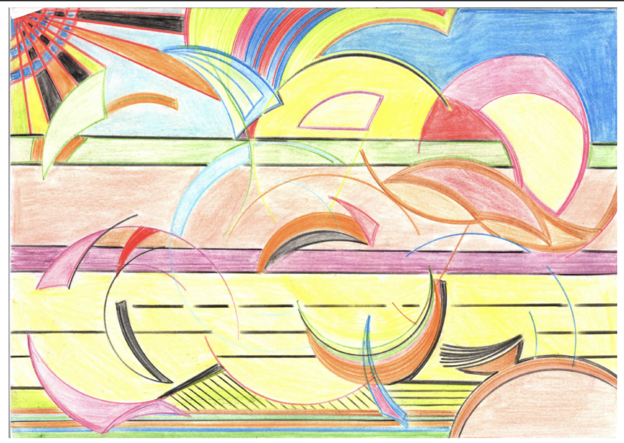'Graphology' drawing poems, by John Kinsella

I am pleased to present a selection of Graphology drawing poems by John Kinsella. You can view the selection HERE and HERE. Below is a commentary provided by John. — A.F.
* * *
On Graphology Drawing Poems
by John Kinsella
Concurrent with writing Graphology Poems by hand and in type (typewriter and computer fonts), I have “concretized” poems by photographing them “in situ” — i.e. as printed or written/marked pages set in trees, against flowers, or as scratchings in dirt, as sticks arranged on a firebreak, or photographed by a third party while holding sheets of poems as “protest placards” — and as textual interjections, overlays, and “culture jamming” of preexisting images/texts. I have also, more prevalently, maybe, made “drawings” and “paintings” … in other words, writing as illustration.
Here is a selection of recent “line/colour/shape” poems.
I have been working at my Graphology Poems since the mid-90s in a publishing sense, and much longer in a “drafting” and “creating” sense. I am deeply interested in the correlation between color and language, between shape and speech, and the narrative implications of lines. I am intrigued by angles and curves — arcs, segments. etc. — measured to the precise degree as well as introducing random chance to define the beginning of a pattern. Angles say much about how we view a person, a tree, a mountain, a bird, the sun, the moon, a kangaroo (changing position, hopping, resting), the roof of a house … and the poem comes alive with all of these observational possibilities and realities in mind.
The making of these works is also about the keeping of a journal (which I have done for four decades, on and off — more on than off) — a day-entry that is a poem draft wherein the signs/marks left on the page by impressions made through working on the previous page (the previous day’s drawing poem draft or “written” entry) … creates subtexts and encryptions to the surface narrative. The show-through, the impression, the valleys and crests created by the pressure of the pencil on the page the day or days prior informs the next installment … part of the same narrative and a fragment entire in itself … a poem sequence. This is representational poetry via a theory of lines, curves … writing and shapes … regarding color.
Yes, I actually have a Graphology Kaleidoscope Series (aside from these works — those poems are all handwritten or typed in recognized fonts) and I have always been intrigued by the controlled (and the tension between the random and the finite) “chance” of the kaleidoscope, and I think of Mallarmé so often when I make these poems on writing, seeing, hearing, touching, tasting, and processing. They are empirical works working against materiality, and in their tangibility become quintessential to a project of translating how we interpret signs, and how we must be wary of the impression our signature (so practiced as a child and not finding its form till necessity drives it as we get older) leaves on all the surfaces and what’s “behind” those surfaces as we live our lives.
Making/constructing/“creating” has consequences, and these poems attempt to be “illustrative writings” of that apparent truism. As I move through phases of illustration becoming pictures, I take the letter and overwrite it, I take the font and look to change its facts, its definitions. One thing I am working towards is altering the keys of am manual typewriter to make them no typeface (outside the mass production die-cast), no consistent font beyond the repetition of those physically altered letters which will bring their own consistency, their own pattern, for poems made on that specific machine. The manual machine as anti-machine. Cage’s prepared piano, but even more in that once changed, there’s no going back. There’s nothing temporary about it beyond entropy, which decides things anyway. I have three old typewriters that have their histories of recording, transcribing, and illustrating.
And now I return to the present series of Graphologies and search for reflections, diffractions and absorptions in the colour wheel of handwriting — working within the constraints of packets of twelve, twenty-four, and forty-eight colours … all of them vegan, and some of them recycled … thrown like dice outside games of chance (which I don’t play anymore) onto acid-free, chlorine-free paper in a vegan-friendly and non-old growth forest journal. The materials matter and speak as much as the show-through marks, the gouges in the pages.
And the rulers, protractors (round, semicircle), set squares, compasses, dividers, and the instruments of hand, arm, body, are part of the vocabulary and acts of translating the figurative into the representational and vice versa. These Graphology Drawing Poems are a subset (I am also obsessed with sets) of Graphology Restoration, which builds in my now.
Graphology Restoration 46: balancing act
Universal Vernier Bevel protractor
is the basis of four directional viewing.
On the salmon gum drawing the sun
shines from four points, theatre in the round,
always sun up sun down or mid-morning
mid-afternoon on the arc of growth
never transiting but fixed — daylighting
the world, azimuth of certainties
one illustration as four corners
but no visual trick, no hoodwink.
Oh, and maybe a pertinent aside, “Graphology Salmon Gum” is actually intended to be shown in four different directions/orientations — as per the clock, as per points of the compass, as per times of the day, if you like. The sun in each corner, the salmon gum tree working (with) its allocation of light in different ways. An ongoing day but always conscious of night.